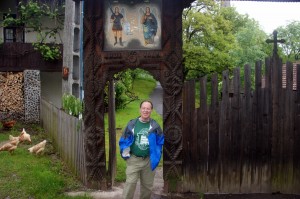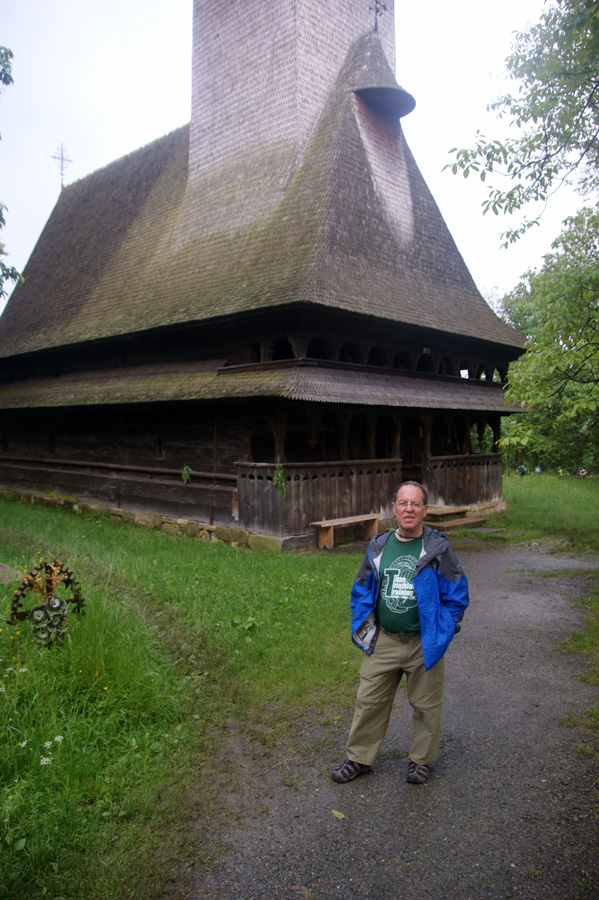
It occurred to me yesterday, as I walked through the park near our hotel, waiting for my transfer to the airport, where European history and American history diverge, particularly in the 20th century. In the park, there was an American aviator monument. Curious, I sought it out. It praised the 378 American airmen who lost their lives in Romania in World War II. By contrast, in one of the museums I visited, I saw that over 100,000 Romanians died after the country switched sides, over 200,000 Jews disappeared, and the country lost over 2 million in the War. Quite a difference, one which again made me glad my grandparents were fortunate enough to have left Europe before World War I.
I took the students to the airport and saw them off, then returned to spend the afternoon in Bucharest. There were two museums I wanted to see–when we were there two years ago, the Royal Palace and the National History museum were closed. I thought I’d take them in, only to discover museums are closed on Monday and Tuesday in Bucharest, at least those two. (The government is planning to cut the budget by 25% next month, so there may be more closings–and more protests; something like 20% of Romanians work for the government).
Instead, I did what I like to do–wander around. The Atheneum, home of the George Enescu Philharmonic, for example, was open; built turn of the last century, it offers 600 seats and 52 boxes, making me wish I could have stayed for the performance of Mozart later in the week. There’re also a lot of Beaux-Arts buildings (I finally figured out what they were) that helped Bucharest vie for the title of the “Paris of the East.” One had a glass-covered mall with shops and a Tiffany-type dome, the palaces of the bourgeoisie. I sauntered past one of the palaces of Vlad Terpes, the model for Dracula; he was a local prince who borrowed some of the Turkish tortures to fight the Turks and other people he didn’t like, and a few of the churches spared by the former Romanian dictator. I had lunch (beef ragout and sausage–hot dogs and beans) in one of Bucharest’s oldest and finest, a gothic restaurant in the old quarter. And I did something I usually do in China, but for some reason, haven’t in Europe–which was a walk in the park, which led me to the plaque that I mentioned above. It was a great place to people watch.

When I left for Baia Mare, the capital of the district of Maramures (a part of Romania that borders the Ukraine and Hungary, both of which have at various times coveted or invaded, or ruled the area, which joined Romania after World War I), I had visions of an idyllic bucolic region with wooden churches and farmers.
The idyllic vision was shattered by my seat mate, an American from Los Angeles, who was going to Baia Mare to check on his company’s aluminum processing plant, which fabricates parts for Airbus! As it turns out, this is in the heart of what was mining country, but with the environmental and other costs, it’s no longer profitable to mine the area, and so various towns around here are scrambling to find a new economic base to avert high unemployment; about half the population worked in the mines. One has built a ski resort, but Baia Mare seems to have a diversified economy, if the diversity of auto dealers I saw on the way in is any indication. I knew it was going to be a different experience, too, when I realized the hotel had a pool, but after all, it’s a Best Western. I had a nice swim last night for the first time on the trip!
This morning, my local guide showed up, and told me he was scheduled for a half -day tour of the city. The first stop was a mineral museum, which testified to the importance of mining (I think these were mostly tailings, but spectacular crystals); the name of the city means Great Mine. We then went to the old town, one that is being renovated and restored to its 17th century glory, including the home of the prince who defeated the Turks and was given the town as a reward. Maybe the most elegant Gothic church in it burned down a hundred years ago, leaving only one of the Prague-style towers; I found out that the four towers around the main one signified that the priest could dispense justice.
I asked the guide if we could arrange a tour out in the countryside–the 80 or so kilometers through the Mara Valley to a town that sounds like spaghetti (I think it’s Sigheti); he rearranged his schedule, and I got in his Dacia (a local car, made in joint venture with Nissan, named for the tribe the Romans defeated, then intermarried with, providing the Romanians with their name), and off we went through the mountains.
The countryside I’d come to see was, happily, there. We saw a lot of horsepower–provided by horses; farmers with hoes in the fields; and best of all, the wooden houses, gates, and churches I’d seen in Bucharest that provided my inspiration to visit Maramures in the first place. In places there were separate villages for Hungarians (my guide told me Hungarians  can teach Hungarian in school; Romanian is a second language). One of the highlights was the “merry cemetery,” which has painted tombstones that indicate people there are not afraid of death. Some are poignant, like the one cursing the taxi driver that killed a girl in front of her house; others are funny, but they’re all in books on the country as one of the places to visit. As we arrived, a funeral was leaving the church!
can teach Hungarian in school; Romanian is a second language). One of the highlights was the “merry cemetery,” which has painted tombstones that indicate people there are not afraid of death. Some are poignant, like the one cursing the taxi driver that killed a girl in front of her house; others are funny, but they’re all in books on the country as one of the places to visit. As we arrived, a funeral was leaving the church!
One of the sights was a prison that the Austrians had built in the 1890s, the Romanians had used during independence, and the Soviets used afterward. The prison now housed a museum that talked about the torture/terror of the Soviet regime, and I learned a lot about the tortured (in more ways than one) period after World War II–how the Russians manipulated a “free election” to take over the country, instituting a terror that landed a lot of politicians and intellectuals in the prison, etc. We’d seen something similar in Budapest about what happened there; the Soviets used the location (code name Danube work colony) because it was so close to the Soviet border that potential escapees would have a hard time escaping.
We had dinner at a picturesque restaurant beside a stream. My guide said, “fish or polenta.” I said, I’ll get the fish, if you’ll get the polenta, and we’ll split. Turned out the fish was a grilled trout, alongside the trout pond it was raised in.
As we were returning, he said there’s one church you have to see; it’s the tallest wooden church (without a foundation and without nails, if you want to know the complete category) and I’ll try to send a picture of it later because it was a Catholic Church, not the dominant Romanian Orthodox.
I’m back now, with a chance to swim before I turn in–and get taken to Sibiu tomorrow. The “take me someplace spectacular I’ve never been before” tour continues.